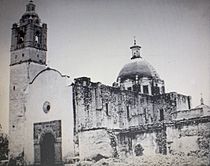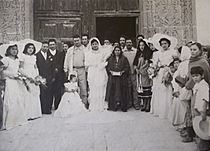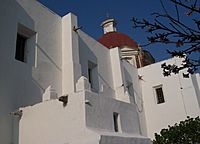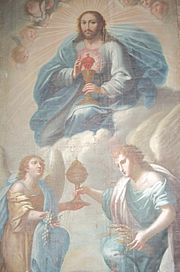Santiago Apóstol Parish (Tequixquiac) facts for kids
Quick facts for kids Santiago Apóstol Parish |
|
|---|---|
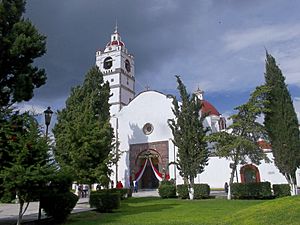
Santiago Apóstol parish in Tequixquiac.
|
|
| 19°54′37″N 99°08′51″W / 19.91034°N 99.14748°W | |
| Location | Santiago Tequixquiac |
| Country | Mexico |
| Denomination | Roman Catholic |
| History | |
| Status | Parish |
| Consecrated | 1590 |
The Santiago Apóstol Parish is a Catholic church and parish house located in downtown Santiago Tequixquiac, Mexico. It belongs to the Diocese of Cuautitlán. The church is dedicated to Saint James the Apostle. It also has a special area where a religious image called the Lord of the Chapel is honored. This historic building is found in the center of town, close to Plaza Cuautémoc and Juárez Avenue. It is a very important colonial building in the Tequixquiac area and has remained in great condition over the years.
Contents
A Look at the Church's History
The government of New Spain, which ruled Mexico long ago, ordered this church to be built in the Teotlalpan region. Franciscan monks helped build churches in areas where Chichimeca people lived. The Santiago Tequixquiac church was in charge of new villages like San Mateo Hueycalco and San Sebastián Tlalachco.
The first Christian church here was built in 1569. However, it was destroyed by a rebellion of the local people. It officially became a parish in 1590. The first priest was a Spanish Franciscan named Juan Arias de León.
Around 1650, a special group from New Spain helped establish Tequixquiac as a town. A priest named Nicolás de Arellano was in charge. This group helped solve problems and settle disagreements among people. They also looked into issues like land disputes and tax collection. More serious problems were sent to Mexico City.
This area was known for its lime and stone mines, which were used for building. One common problem was the unfair treatment of local workers. They were often forced to work and faced harsh conditions. A priest named Felix de Peñafiel wrote a report for the Archbishop. This report included how many people lived there, what Christian teachings were shared in Spanish, Nahuatl, and Otomi, and records of baptisms.
During a time of drought, a sculpture called "Señor de la Capilla" (Our Lord of the Chapel) was brought to Tequixquiac from Apaxco. When the drought ended, the statue was not returned. It was said to be too heavy to carry back because it was made of fiber. This statue has stayed in Tequixquiac and many people believe it has brought about miracles.
The 19th and 20th Centuries
In 1804, a German explorer named Alexander von Humboldt visited Tequixquiac. He came to study the land and how water drained from Mexico City through Zumpango. He noticed that a priest at the church was treating the local people poorly.
After Mexico became independent, important public events happened inside the church. These included celebrations, the election of Tequixquiac's first mayor in 1826, and a vote in 1851. This vote was to create a local guard to protect the people. The army at the time could not always keep people safe from conflicts happening in the country.
When the Mexican Revolution started in 1910, the church building was left empty. Soldiers used the inside as stables, which led to damage and theft. In 1917, the Zapatista army, led by Otilio Montaño, took control of Tequixquiac. The people asked for the church to be reopened. This did not happen right away. However, in 1927, the government of Mexico State and the church leaders agreed to the people's requests, and the Santiago Apóstol Parish church was reopened.
In 1990, the church celebrated its 400th anniversary. It was a big party with traditional dances, music, and many baptisms, weddings, and first communions. The local government helped support cultural events like classical music, folk dance, and theater. There were also sports events and traditional food. People from other parts of Mexico and even from Spain, Italy, and the United States were invited.
The 21st Century and Today
On December 16, 2006, some church members asked for the pastor to be removed.
Church Art and Design
Architecture: The Church Building
This church was built in different stages, mostly by local workers. Religious leaders oversaw the design. The building style is called tlaquitqui. This means it includes some local symbols and ideas in its design.
The front of the church has two beautifully decorated doorways made of stone. These decorations include symbols from the local culture. Both the church and the town are named after Apostle James.
The church has strong supports called counterforts. These help hold up the arched ceiling and dome. The walls are very thick, which also helped protect the church in case of local uprisings long ago. The building and its tower show a strong influence from Moorish (Islamic) art. The tower looks similar to minarets found in Islamic architecture.
The churchyard, called the atrium, was a large stone area with a cross on top. Its walls also mixed Christian and local symbols. In each of its four corners, there were wells. In the center, there was an open space with twisted columns called Solomonic columns.
Inside the Church
Paintings and Murals
The church has beautiful Baroque artworks, including paintings from the 16th and 17th centuries. These paintings mainly show themes like St. Michael the Archangel, the Sacred Heart of Jesus, and purgatory.
There are also murals painted on the domes inside the church. In the sacristy dome, there is a painting of La crucificción de Jesucristo (Jesus Christ's crucifixion). The dome represents heaven, with angels, cherubs, and saints looking on. The main part of the painting shows Christ being taken down from the cross.
Traditional Dances
The Contradanza de las Varas is a traditional dance performed by men during town celebrations. It comes from northern Spain, not from local indigenous dances. It is danced on July 25th to honor Saint James the Apostle. It was brought by settlers in 1652 as a tribute to God. Later, it was also danced to honor the Lord of the Chapel. The name contradanza comes from the two rose sticks used in the dance. These sticks have colorful ribbons that move with the dance steps.
Another dance is La Trenza (The Braid). This dance is performed only on Mondays during the Lord of the Chapel fair. Dancers use a colorful pole with braided ribbons while marching band music plays.
Literature and Writings
Some of the first artistic writings from this parish were Las Loas. These were poems inspired by the Lord of the Chapel and later by the Lord of the Agony during Holy Week. They were religious songs and speeches that men sang and prayed to Jesus Christ before Easter. The Loas are poetic verses that are still known today by the local people. The church has also seen other important writings, like the creation of the first town council in 1814.
In 2023, Manuel Rodríguez Villegas wrote a novel called The Fruits of Holy Land. This Mexican novel was presented at the Book Fair of Madrid on May 27, 2023. The story takes place in the Santiago Apóstol parish during the time of New Spain. The main character is Ester Silva, a Jewish woman who converted to Catholicism. She moved from Seville with her husband and settled in Tequixquiac. Many happy and sad events happen to her family in the parish. The book explores religious and historical themes during a time when people were not always tolerant. It also shows how a new kind of Catholicism developed in New Spain.
Important People Connected to the Church
- Alexander von Humboldt visited Tequixquiac to study the land and water drainage for Mexico City. He noticed that a priest at the church was treating the local people poorly.
- Fortino Hipólito Vera y Talonia was born and baptized at Santiago Tequixquiac. He became one of the first bishops of Cuernavaca. His remains were brought back from Cuernavaca to this church in 1938 and are kept inside.
List of Priests Over Time
See also
 In Spanish: Parroquia de Santiago Apóstol (Tequixquiac) para niños
In Spanish: Parroquia de Santiago Apóstol (Tequixquiac) para niños
- Teotlalpan
- Spanish missions in Mexico


